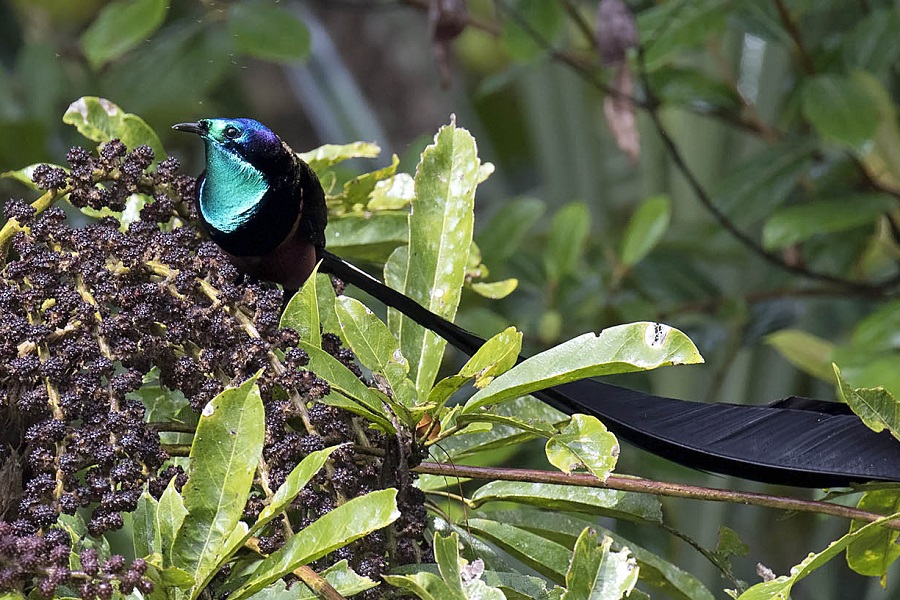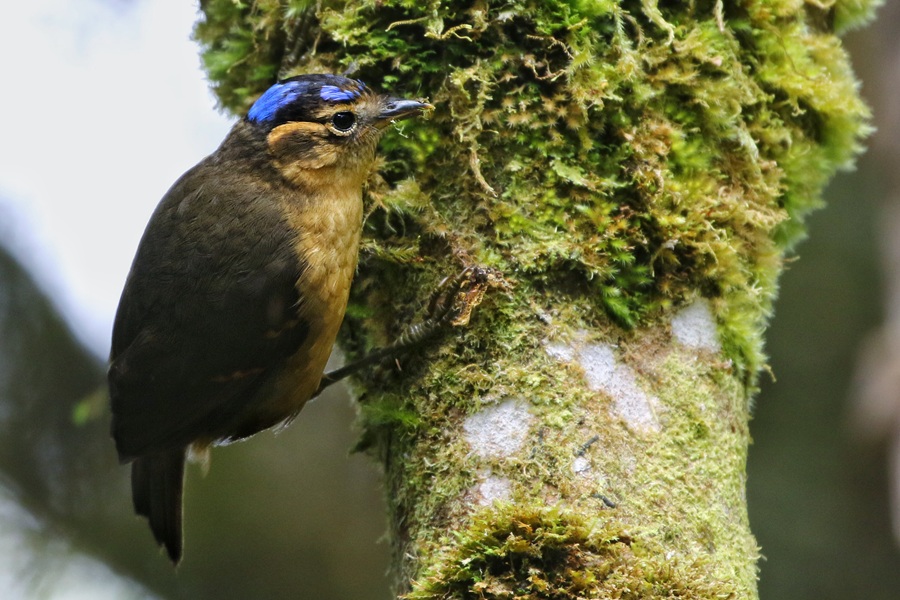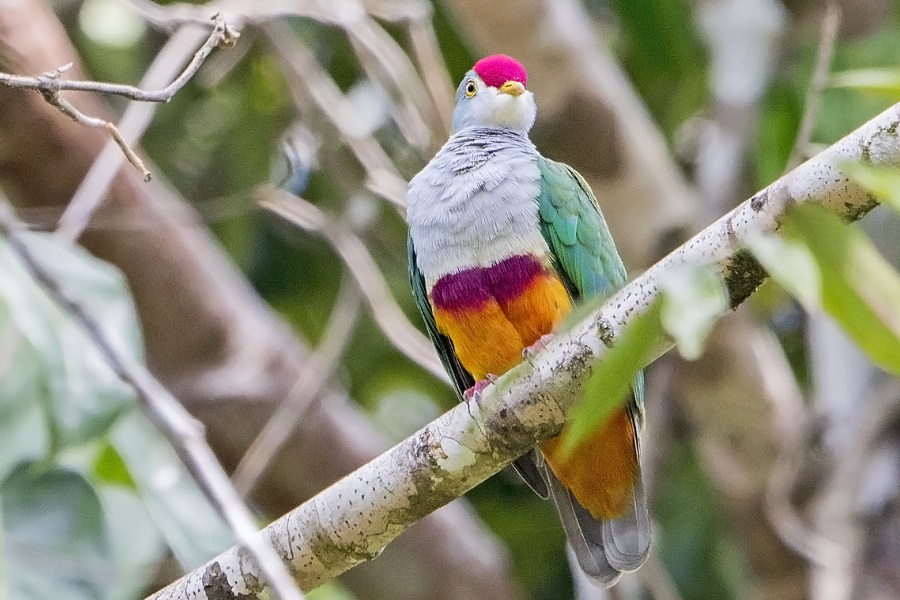Papua New Guinea: Mainland
Comprehensively explore the classic mainland route around PNG, with our experienced leaders enjoying unparalleled success in finding the hardest species in this challenging country. This tour features extra time at Varirata to search out Pheasant Pigeon and Forest Bittern, several chances for desirable highland species like Wattled Ploughbill and Blue Bird-of-paradise, plus Tabubil for Shovel-billed Kookaburra and two nights in forest up the Fly River for Flame Bowerbird, Spangled Owlet-nightjar, Campbell's Fairywren, and New Guinea Flightless Rail. Then, visit the Huon Peninsula for Wahnes's Parotia, Emperor Bird-of-paradise, Huon Astrapia, and more. All up, a very exciting adventure, with the best chance at all seven endemic families, plus a dazzling array of colourful parrot, dove, honeyeater, and bird-of-paradise species!
Next Dates
23 August - 15 September 2026 (24 days)
Leaders:
Chris Venetz
Group Size Limit:
7
Single Room Supplement: $
1500 USD
Deposit: $
1500 USD
Price: $
16400 USD
Add a Title
Leaders:
Chris Venetz
Group Size Limit:
Add a Title
Single Room Supplement: $
TBD
Deposit: $
TBD
Price: $
TBD
Add a Title
23 August - 15 September 2028 (24 days)
Leaders:
Donna Belder
Group Size Limit:
7
Single Room Supplement: $
1500 USD
Deposit: $
1500 USD
Price: $
16400 USD
Add a Title
Leaders:
Donna Belder
Group Size Limit:
Add a Title
Single Room Supplement: $
TBD
Deposit: $
TBD
Price: $
TBD
Add a Title
In recent years, Papua New Guinea's domestic flight network has become extremely unreliable. Our main tour has been designed with several charter flights and plenty of extra time for connections when required, so it is unlikely that birding will be majorly affected by any flight delays.
Accommodation:
Excellent hotels in Port Moresby and around Mount Hagen. Comfortable hotels in Kiunga and Tabubil. Very basic guesthouse with shared rooms, facilities and cold water for our two nights up the Fly River (uncomfortable, but necessary for some of the best lowland birding and spotlighting in New Guinea!). In the Huon Extension, we will be in a safari-style tented camp in the forest with shared walk-in tents and facilities, but there is hot water and WiFi!
Walking difficulty:
To fully participate in this tour, participants should be able to keep balance and walk comfortably at a birding pace on muddy/uneven/steep trails for several hours at a time. We also welcome any participants who feel they might not quite be at this level of fitness, but caution there will be two or three birding sessions which you might choose to skip. Please email us if you are unsure or want more details.
Tour cost includes:
All accommodation, main meals, drinking water, internal flights (as stated in itinerary), overland transport, tips to local drivers and guides, travel permits, entrance fees, and guide fees.
Tour cost excludes:
Flights before and after the tour start/end, visa, travel insurance, tips to tour leaders, laundry, drinks, and other items of a personal nature.


NOTE: We will not be running this tour in 2027, to avoid possible complications with the Papua New Guinea elections, which usually bring about short-term riots in Mount Hagen. The next scheduled departure will be in 2028.
This is our most comprehensive Papua New Guinea tour along the classic route. For those who wish to see our shorter Highlights version, click here!
Day 1-2: After early arrivals into Port Moresby International Airport (POM) on Day 1, we will drop our bags at the hotel and head straight out to the famous Varirata National Park, where we will be birding for the next two days. Here, we will look for flamboyant Raggiana Birds-of-paradise at their display tree – with luck, some females will drop by and send the males into a frenzy of display! Sneaky Growling Riflebirds and Crinkle-collared Manucodes move through the canopy, and we will search for beautiful Brown-headed Paradise Kingfishers, the skulking Chestnut-backed Jewel-babbler and Painted Quailthrush, a huge assortment of pigeons and honeyeaters, as well as many other exciting birds like Black-billed Brushturkey, Barred Owlet-nightjar, Rufous-bellied Kookaburra, Wallace’s Fairywren, Goldenface, White-bellied Whistler, the poisonous Hooded Pitohui, Hooded Butcherbird, Chestnut-bellied Fantail, and Golden Monarch. We may see our first of New Guinea’s unique endemic families here, with both Black Berrypecker and Dwarf Longbill regularly encountered. It would not be unusual after these two days to have recorded close to 50 New Guinea endemics in this wonderful park, hopefully including some of the harder targets like Forest Bittern, Pheasant Pigeon, Crested Bellbird, and Papuan Scrub Robin! Nights in Port Moresby.
Day 3: Today, we will take a short flight to Mount Hagen and transfer to the homely Kumul Lodge, where we will stay for the next three nights. Upon arrival, we will be immediately greeted by Ribbon-tailed Astrapias on the feeding table, alongside Belford’s Melidectes, Brehm’s Tiger Parrot, and Common Smoky Honeyeater. The surrounding gardens are regularly visited by the unique Crested Satinbird, noisy Blue-capped Ifrit, and beautiful Eastern Crested Berrypecker, all of these representing endemic bird families found only in New Guinea! Other species here include Forbes’s Forest Rail, Feline and Mountain Owlet-nightjars, Archbold’s Nightjar, New Guinea Woodcock, White-winged Robin, Mountain Firetail, and Rusty-naped Bellbird (closely related to the Crested Bellbird of Australia!). Night at Kumul Lodge.
Day 4-5: Visiting several sites in the vicinity of the lodge, we will be astounded by the luminous Blue Bird-of-paradise, otherworldly King-of-Saxony Bird-of-paradise, and immense Brown Sicklebill, three of the most exciting “BoPs” of the highlands! We should also see other good-looking birds such as Greater Lophorina, Tit Berrypecker, Ornate Melidectes, Black-breasted Boatbill, Regent Whistler, Plum-faced Lorikeet, Orange-billed Lorikeet, plus a large assortment of interesting small birds like Mountain Mouse-warbler and Brown-breasted Gerygone. In some drier habitat, we will look for Yellow-breasted Bowerbird, Black-headed Whistler, Mountain Honeyeater, and Papuan Grassbird, then check some cascades for the strange Torrent Flyrobin. We will work hard to entice the skulking Lesser Melampitta into view, spot a flightly Mottled Berryhunter in the midcanopy, and track down high-pitched calls of the male Wattled Ploughbill - these three birds representing the remaining endemic bird families (though some will be significantly easier to see in the coming days at Rondon). Nights at Kumul Lodge.
Day 6: After a final morning at Kumul, we will drive to the luxurious Rondon Ridge for a three-night stay.
Day 7-8: The star attraction of Rondon is its unequalled variety of birds-of-paradise. We should encounter Loria’s Satinbird and the odd-looking Short-tailed Paradigalla, while higher up the road we will look for the beautiful Princess Stephanie’s Astrapia, and have another chance for King-of-Saxony Bird-of-paradise. Lower down, we will search fruiting trees for Lawes’s Parotia, and we will have another chance for Blue Bird-of-paradise. Along the forest edge, we have more chances for Blue-capped Ifrit, Wattled Ploughbill, and Mottled Berryhunter. This is also a good area for the immense New Guinea Eagle, closely related to the Harpy Eagle of South America. Other targets include the shy Macgregor’s Bowerbird, Painted, Modest, and Madarasz’s Tiger Parrots, Spotted Jewel-babbler, Papuan Logrunner, Chestnut Forest Rail, Ashy Robin, Lesser Ground Robin, Papuan Treecreeper, Black Pitohui, Black Sittella, and Spotted Berrypecker. At night, Papuan Boobook is usually common, while Archbold’s Nightjar might be staked out for us. There is of course the usual assortment of robins, whistlers, honeyeaters, pigeons, and scrubwrens to also look for in this very diverse area!
Day 9: After one more morning of birding in Rondon, we fly to Kiunga (using a charter flight, since this route is notoriously unreliable on commercial tickets). Transferring in 4WDs up to Tabubil, we will settle in for the next four nights.
Day 10-11-12: Tabubil is the best spot in New Guinea to access good hill forest favoured by some mouthwatering specialties. One of the best is the retiring Shovel-billed Kookaburra, which we have managed to pin down quite well and have not missed for several years! Queen Carola’s Parotia and Magnificent Bird-of-paradise can usually be seen from an overlook north of town, where Obscure Berrypecker and White-rumped Robin sneak by in the vegetation. The handsome Torrent-lark and Salvadori’s Teal favour an area of rapids to the south, where Great Woodswallow and Mountain Peltops often sit along the powerlines. Further afield, there are always new places to explore, including the newly opened road to Telefomin, and we hope to repeat previous successes where we have seen the alien Yellow-breasted Satinbird, the unique Greater Melampitta, the smart Wallace’s Fairywren, and the amazing Pesquet’s Parrot. Recent sightings of the almost unknown Sooty Shrikethrush give us hope to see this extreme rarity too. Striated Lorikeet and Yellow-eyed Starling sometimes pass overhead, and we will be on the lookout for White-eared Bronze Cuckoo, Spotted Honeyeater, and Orange-breasted Fig Parrot (amongst many others!).
Day 13: After the morning around Tabubil, we drive back to Kiunga, spending our afternoon at the famous “KM17”, where the Greater Bird-of-paradise scenes were filmed for David Attenborough’s “Life of Birds” documentary. The birds have since moved a few trees over, but still put on a great show whenever the females pop by! We will have our first chance to see the tiny King Bird-of-paradise here, as well as both Papuan and Hooded Pittas. We might also come across the rare Wallace’s Owlet-nightjar and bubbling Marbled Frogmouth after dark. Night at Kiunga.
Day 14-15-16: Our two-night/three-day boat trip up the mighty Fly River is always the most exciting section of this tour, with the next two nights at a basic guesthouse in the forest before we return to our Kiunga hotel late on Day 16 for much-needed showers! Due to an excellent ecotourism program, the forest lining the Elevala River tributary where we will be based is protected and full of birds. Huge trees dangle their vegetation into the water and footprints on muddy banks often betray the presence of unseen Southern Cassowaries. There is a huge number of species to look for here, but among the most spectacular are Sclater’s Crowned Pigeon (usually found eyeing us cautiously from a conspicuous perch in the early morning), Twelve-wired Bird-of-paradise (typically calling loudly from his display pole visible from our guesthouse balcony), and the glowing Flame Bowerbird (with luck, our local guides will have found a bower for us to stake out). Other mega birds include New Guinea Flightless Rail, Spangled Owlet-nightjar, Papuan Hawk-Owl, Hook-billed Kingfisher, Little Paradise Kingfisher, Blue Jewel-babbler, and Campbell’s Fairywren. More common species include Lowland Peltops, Large Fig Parrot, Golden Myna, White-bellied Pitohui, Papuan Babbler, Long-billed Cuckoo, many more parrots and pigeons, plus the occasional Long-tailed Honey Buzzard, Pesquet’s Parrot, or Obscure Honeyeater.
Day 17: Our last morning at Kiunga will focus on the accessible roadside forests closer to town in search of some new species. We will likely be spending time at a forested overlook on Boystown Road, where Emperor Fairywren is often seen, or scanning some fields for the endemic White-spotted Mannikin. Towards the middle of the day, we fly back to Port Moresby. If we did not do it already at the start of the tour, there may be time for some open-country birding in the evening, looking for Orange-fronted Fruit-Dove, Grey-headed Mannikin, Black-backed Butcherbird, and Papuan Frogmouth. Night in Port Moresby.
Day 18: Morning flight to Lae, and depending on the weather, we may be able to board our plane to the Huon this afternoon. Otherwise, we will overnight in Lae and fly out the following day.
Day 19: Gliding over the Huon Peninsula to land at Wasu on the north coast, we will be driven up to the permanent camp in 4WDs and commence our exploration of this wonderful area.
Day 20-21-22: The Huon Peninsula is most famous for three endemic birds-of-paradise, all of which we expect to see during our stay! At lower elevations, Emperor Bird-of-paradise lek in the crowns of tall forest trees, betraying their presence with an irregular cacophony of sound. On the mid-slopes, we will see Wahnes’s Parotia and the incredibly long-tailed Huon Astrapia, both regularly visiting fruiting trees and usually giving great views. There are three other endemic birds we can target: Spangled Honeyeater is usually found without difficulty at the higher points along the road, while the retiring Huon Catbird and Huon Bowerbird are both trickier and require good luck to chance across. Unfortunately Huon Melidectes is usually not found in this area, only in the highest reaches of the mountain range.
Plenty of other birds are found in this forest, which is probably the best accessible site in New Guinea to see the unique Pesquet’s Parrot and the monotypic Mottled Berryhunter, both of which are easy to miss elsewhere on the island. We have also recently had success here with some tricky mid-elevation species like Streaked Berrypecker and White-eyed Robin. Other species could include Mountain Kingfisher, Spotted Jewel-Babbler, Forbes’s Forest Rail, Tit Berrypecker, Black-mantled Goshawk, Blue-capped Ifrit, Greater Lophorina, White-eared Bronze Cuckoo, Papuan King Parrot, Fairy Lorikeet, Ornate Fruit Dove, Great Cuckoo Dove, Rufescent Imperial Pigeon, Cinnamon-browed Melidectes, Red-collared Myzomela, Black-throated Honeyeater, Marbled Honeyeater, Buff-faced Scrubwren, Black-breasted Boatbill, Mountain Peltops, Stout-billed Cuckooshrike, Brown-backed Whistler, Sepik-Ramu Shrikethrush, Mid-mountain Berrypecker, Streaked Berrypecker, Canary Flyrobin, Black-throated Robin, Slaty Robin, and hopefully the poorly-known White-eyed Robin which we discovered in some small patches of forest on our 2024 tour.
Day 23: Today we fly back to Lae for an overnight stay near the airport.
Day 24: After breakfast, we will fly back to Port Moresby (POM), where this exciting tour ends this afternoon.
NOTE: We are also able to arrange a four night extension to Walindi on the island of New Britain upon request. This could be escorted either by the Ornis leader, or a competent lodge bird guide from Walindi Resort. This would follow the itinerary of our usual extension for Papua New Guinea: Islands.




































.jpg)





